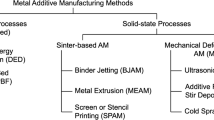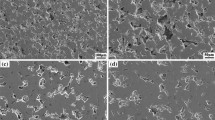Abstract
This study explores the impact of additive manufactured porous architecture on the tribological performance of Ti6Al4V. Biomimetic porous architectures were manufactured on dense multi-layer using direct energy deposition with a dense layer followed by a porous layer. Varied scanning intervals during laser processing for the porous layer influenced the microstructure and, consequently, the hardness, the corrosion resistance and the tribological behavior of the dense layer. The results indicate a substantial improvement in tribocorrosion performance, particularly noteworthy in reducing corrosive wear rates, making porous architectures beneficial for both biomimetic structures and enhanced tribocorrosion resistance in body fluids.
Graphical abstract





Similar content being viewed by others
Data availability
Data will be shared on reasonable request.
References
M.-M. Germaini, S. Belhabib, S. Guessasma, R. Deterre, P. Corre, P. Weiss, Additive manufacturing of biomaterials for bone tissue engineering—a critical review of the state of the art and new concepts. Prog. Mater. Sci. 130, 100963 (2022)
S. Acharya, R. Soni, S. Suwas, K. Chatterjee, Additive manufacturing of Co-Cr alloys for biomedical applications: a concise review. J. Mater. Res. 36, 3746 (2021)
R. Shah, N. Pai, A. Rosenkranz, K. Shirvani, M. Marian, Tribological behavior of additively manufactured metal components. J. Manuf. Mater. Process. 6, 138 (2022)
L. Zhang, Q. Ma, J. Ding, S. Qu, J. Fu, M.W. Fu, X. Song, M.Y. Wang, Design of elastically isotropic shell lattices from anisotropic constitutive materials for additive manufacturing. Addit. Manuf. 59, 103185 (2022)
X.-Y. Zhang, G. Fang, S. Leeflang, A.A. Zadpoor, J. Zhou, Topological design, permeability and mechanical behavior of additively manufactured functionally graded porous metallic biomaterials. Acta Biomater. 84, 437 (2019)
M. Roudnicka, F. Bayer, A. Michalcova, J. Kubasek, E.G.H. Alzubi, D. Vojtech, Biomedical titanium alloy prepared by additive manufacturing: effect of processing on tribology. Manuf. Technol. J. 20, 809 (2020)
K.C. Sanjeev, P.D. Nezhadfar, C. Phillips, M.S. Kennedy, N. Shamsaei, R.L. Jackson, Tribological behavior of 17-4 PH stainless steel fabricated by traditional manufacturing and laser-based additive manufacturing methods. Wear 440, 203100 (2019)
W.Z. Zhai, A.D. Sun, W.H. Zeng, W.L. Lu, X.J. Liu, L.P. Zhou, J. Wang, A.M.M. Ibrahim, High wear resistance and mechanical performance of NiAl bronze developed by electron beam powder bed fusion. Tribol. Lett. (2021). https://doi.org/10.1007/s11249-021-01534-7
M. Marquer, P. Laheurte, L. Faure, S. Philippon, Influence of 3D-printing on the behaviour of Ti6Al4V in high-speed friction. Tribol. Int. 152, 106557 (2020)
H. Sasaki, F. Takeo, H. Soyama, Cavitation erosion resistance of the titanium alloy Ti–6Al–4V manufactured through additive manufacturing with various peening methods. Wear 462–463, 203518 (2020)
Y. Zhu, J. Zou, X. Chen, H. Yang, Tribology of selective laser melting processed parts: stainless steel 316 L under lubricated conditions. Wear 350–351, 46 (2016)
P. Renner, S. Jha, Y. Chen, A. Raut, S.G. Mehta, H. Liang, A review on corrosion and wear of additively manufactured alloys. J. Tribol. (2021). https://doi.org/10.1115/1.4050503
Z. Azakli, R. Gümrük, Particle erosion performance of additive manufactured 316L stainless steel materials. Tribol. Lett. 69, 130 (2021)
Y. Yang, Y. Zhu, H. Yang, Enhancing wear resistance of selective laser melted parts: influence of energy density. J. Tribol. (2020). https://doi.org/10.1115/1.4047297
B. Sagbas, G. Gencelli, A. Sever, Effect of process parameters on tribological properties of Ti6Al4V surfaces manufactured by selective laser melting. J. Mater. Eng. Perform. 30, 4966 (2021)
C.J. Hassila, P. Harlin, U. Wiklund, Rolling contact fatigue crack propagation relative to anisotropies in additive manufactured Inconel 625. Wear 426–427, 1837 (2019)
T.H. Kim, K.C. Bae, J.B. Jeon, Y.H. Park, W. Lee, Building-direction dependence of wear resistance of selective laser melted AISI 316L stainless steel under quasi-stationary condition. Tribol. Lett. 68, 76 (2020)
A. Ataee, Y.C. Li, C.E. Wen, A comparative study on the nanoindentation behavior, wear resistance and in vitro biocompatibility of SLM manufactured CP-Ti and EBM manufactured Ti64 gyroid scaffolds. Acta Biomater. 97, 587 (2019)
M.M. Hanon, R. Marczis, L. Zsidai, Impact of 3D-printing structure on the tribological properties of polymers. Ind. Lubr. Tribol. 72, 811 (2020)
H. Li, M. Ramezani, M. Li, C. Ma, J. Wang, Tribological performance of selective laser melted 316L stainless steel. Tribol. Int. 128, 121 (2018)
A. Mahajan, G. Singh, S. Devgan, Additive manufacturing of metallic biomaterials: a concise review. Arch. Civil Mech. Eng. 23, 187 (2023)
P. Chandramohan, S. Bhero, B.A. Obadele, P.A. Olubambi, Laser additive manufactured Ti-6Al-4V alloy: tribology and corrosion studies. Int. J. Adv. Manuf. Tech. 92, 3051 (2017)
Y.J. Wang, Y.L. An, G.L. Hou, X.Q. Zhao, H.D. Zhou, J.M. Chen, Effect of cooling rate during annealing on microstructure and ultrasonic cavitation behaviors of Ti6Al4V alloy. Wear (2023). https://doi.org/10.1016/j.wear.2022.204529
K. Mutombo, C. Siyasiya, W.E. Stumpf, Diffusional transformation in Ti6Al4V alloy during isothermal compression. Trans. Nonferr. Metal Soc. 29, 2078 (2019)
A. Ho, H. Zhao, J.W. Fellowes, F. Martina, A.E. Davis, P.B. Prangnell, On the origin of microstructural banding in Ti-6Al4V wire-arc based high deposition rate additive manufacturing. Acta Mater. 166, 306 (2019)
G.H. Zhang, Z.W. Hao, M. Wang, X.F. Lu, Z. Zhao, Q. Wang, X. Lin, J. Chen, W.D. Huang, Globularization mechanism and near isotropic properties in subcritical heat-treated Ti6Al4V fabricated by directed energy deposition. Acta Metall. Sin.-Engl. 36, 937 (2023)
X.A. Zhao, F.C.T. So, M.A. Nicolet, TiAl3 formation by furnace annealing of Ti/Al bilayers and the effect of impurities. J. Appl. Phys. 63, 2800 (1988)
E. Ghio, E. Cerri, Additive manufacturing of AlSi10Mg and Ti6Al4V lightweight alloys via laser powder bed fusion: a review of heat treatments effects. Materials 15, 2047 (2022)
R. Sabban, S. Bahl, K. Chatterjee, S. Suwas, Globularization using heat treatment in additively manufactured Ti-6Al-4V for high strength and toughness. Acta Mater. 162, 239 (2019)
K. Lin, D. Gu, L. **, L. Yuan, S. Niu, P. Lv, Q. Ge, Selective laser melting processing of 316L stainless steel: effect of microstructural differences along building direction on corrosion behavior. Int. J. Adv. Manuf. Tech. 104, 2669 (2019)
Acknowledgments
This research was supported by the National Natural Science Foundation of China (Grant No. 51875169). **ulin Ji acknowledges the support from the STU Scientific Research Foundation for Talents (NTF21011). Fengtao Wang would like to acknowledge the support from the 2020 Li Ka Shing Foundation Cross-Disciplinary Research (2020LKSFG01D) and Guangdong Provincial University Innovation Team Project (2020KCXTD012).
Funding
Funding was provided by National Natural Science Foundation of China (Grant No. 51875169), STU Scientific Research Foundation for Talents (Grant No. NTF21011), Li Ka Shing Foundation Cross-Disciplinary Research (Grant No. 2020LKSFG01D) and Guangdong Provincial University Innovation Team Project (Grant No. 2020KCXTD012).
Author information
Authors and Affiliations
Contributions
XJ: methodology, investigation, data curation, writing—original draft, writing—review and editing, resources, supervision. JW: methodology, investigation, data curation. HD: formal analysis, resources, conceptualization. YL: methodology, visualization. FW: conceptualization, methodology, resources.
Corresponding author
Ethics declarations
Conflict of interest
The authors declare no competing financial interests or personal relationships that may have influenced the results reported in this paper.
Additional information
Publisher's Note
Springer Nature remains neutral with regard to jurisdictional claims in published maps and institutional affiliations.
Supplementary Information
Below is the link to the electronic supplementary material.
Rights and permissions
Springer Nature or its licensor (e.g. a society or other partner) holds exclusive rights to this article under a publishing agreement with the author(s) or other rightsholder(s); author self-archiving of the accepted manuscript version of this article is solely governed by the terms of such publishing agreement and applicable law.
About this article
Cite this article
Ji, X., Wang, J., Zhu, W. et al. Enhancing tribological performance of Ti6Al4V with additively manufactured porous architecture: A scanning interval approach. MRS Communications (2024). https://doi.org/10.1557/s43579-024-00515-w
Received:
Accepted:
Published:
DOI: https://doi.org/10.1557/s43579-024-00515-w




